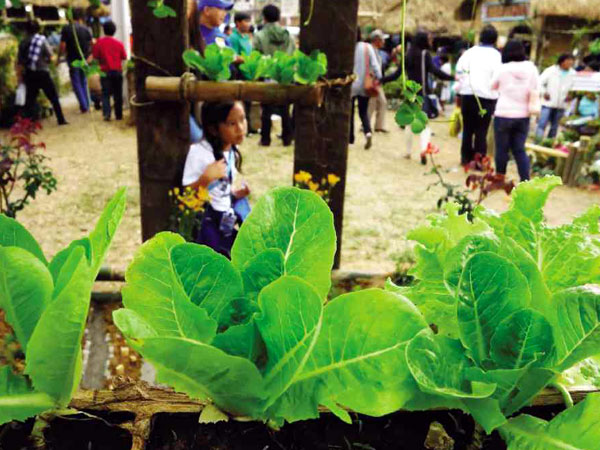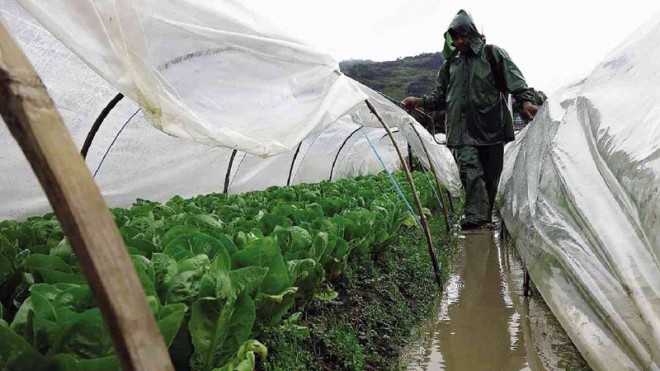Before chop suey were ‘veggie kings’

VEGETABLES put on display in last year’s Adivay Festival in La Trinidad town in Benguet province were introduced to local farmers by Chinese migrants and have become the province’s most lucrative commodity. EV ESPIRITU
After a long stint abroad either as overseas workers or migrants, among the first things Baguio City residents would seek when returning home to the summer capital is chop suey, a mixed vegetable dish the Chinese popularized.
Most visitors from Metro Manila and elsewhere would also not miss bringing home “gulay Baguio” after their trip to the summer capital.
But how these vegetables were introduced to Baguio and the Cordillera remains unknown to many.
Retracing how these vegetables were first propagated is rediscovering that those who introduced these were very much part of the city’s history and development.
Cabbage, for example, was first introduced by Tai Kien, an ethnic Chinese who opted to settle in Baguio in the 1930s.
The late Dr. Charles Cheng and Katherine Bersamira-Cheng, in their 1997 book, “The Ethnic Chinese in Baguio and in the Cordillera Philippines,” said Tai Kien was among those who stayed after helping build Kennon Road, a major infrastructure project of the American colonial regime when the Americans discovered the cool mountain climate of Baguio and sought to establish a hill station and health resort for their soldiers and officials.
A farming expert, Tai Kien settled in Lucban village where he rented some plots of land. “After two years of difficult experimentation, Tai Kien was able to germinate a new variety of cabbage seedling,” the Chengs wrote.
It was the first successful experiment as no one was able to propagate the cabbage variety, the authors said. For this, Tai Kien was regarded as the “Cabbage King.”
Tai Kien’s son, Tai Pong, also followed his father’s lead and maintained a farm in the Old and New Lucban areas. He experimented on propagating celery and later earned the moniker, “Celery King.”
Also at Old Lucban, Chan Kok Shiu was able to propagate another variety of broccoli.
At his farm in Leonila Hill, Puan Sing experimented on lettuce and was able to produce a new variety, which he called “parapad type.”

HIGHLAND GREENS FOR THE LOWLAND. Vegetables grown in Benguet are shipped to various markets in Metro Manila and other provinces no matter how bad the weather gets. Chinese migrants, who built Kennon Road during the American colonial rule, introduced vegetable-growing to Benguet farmers. Salad vegetables have become the province’s most lucrative commodity. EV ESPIRITU/INQUIRER NORTHERN LUZON
In the accounts of the Chengs, Chan was acknowledged as the “Broccoli King” and Puan, the “Lettuce King.”
In neighboring Benguet province, in the village of Loo in Buguias town, another Chinese migrant experimented on the “womboc” or Chinese cabbage. Tomas Yap was recognized by the provincial government for succeeding in culturing a womboc variety that weighed 5 kg.
Several vegetable varieties and other plants were eventually introduced not only in the Cordillera region but in other parts of the country, the authors said. These included “pechai” (another variety of Chinese cabbage), “kuchai” (small onion), “tungsoi” (watercress), “batao” (hyacinth bean), “tunghao” (crown daisy), “sitao” (cow pea) and “kangkong” (swamp cabbage).
Flowers, too
The seeds of the flower industry also began with the pioneering efforts of ethnic Chinese farmers.
The authors cited Ruben Kantala, the acknowledged “Rose King of Benguet,” who started experimenting on wild roses at Camp 3 in Tuba town, Benguet. He skillfully grafted the wild roses and cultured them to produce various varieties of sweet scented, big roses, which he called “Happiness” and “Holland Roses.”
Another was Ayben Chan or Tai Ping, who succeeded in propagating various varieties of gladiola, an effort that earned her the distinction of “Gladiola Queen.”
In agriculture alone, the Chengs cited other stories of the migrant Chinese’s pioneering efforts, which helped lay the foundation for Benguet’s vegetable industry.
What are now called “good agricultural practices” by the Department of Agriculture have actually been introduced by the Chinese.
The authors cited composting, nutrient recycling of organic matter, rotating crops, using residues in farms, water hydraulic techniques of drawing water for highland irrigation and natural pest control such as using predatory ants against pests.
The pioneers also introduced preserving bats to control insects at night and to help in pollination and seed propagation.
Processed human waste or “night soil” was also introduced as fertilizer aside from the use of expensive and imported soya bean cake for fertilizer, the authors said.
The growing vegetable industry has continued to sustain the local food business.
Through the Chinese, Cordillera folk were introduced to “new varieties of dining pleasures,” the Chengs said.
Locals were introduced to the “mi” or noodles such as “mami,” “lomi,” “miki” and “miswa,” and different varieties of “pancit” or sautéed noodles with shrimps, meat and vegetables.
They cited Luy Yiam, also known was Wong Heng, who introduced “sotanghon.” As a young man yearning for adventure, he left his province of Canton in China at age 17, and ended up in Manila in 1921, where he first ventured in vegetable trading.
He came to Baguio in 1931 and continued trading vegetables to his clients at Chinatown. After World War II, during which he fought side by side Filipino guerrillas, he started a sotanghon factory in Barangay (village) Pico in La Trinidad town, Benguet.
He likewise embarked on a piggery and poultry farm and became, at one time, president of a farmers’ association in La Trinidad.














